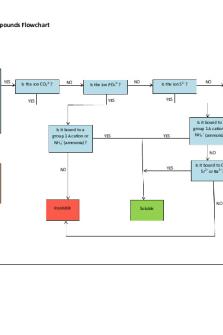7.c Solubility key - Homework PDF

| Title | 7.c Solubility key - Homework |
|---|---|
| Course | Inorganic Chemistry |
| Institution | Old Dominion University |
| Pages | 3 |
| File Size | 111.9 KB |
| File Type | |
| Total Downloads | 14 |
| Total Views | 165 |
Summary
Homework...
Description
Solubility and Precipitation Reactions Activity The extent to which a substance may be dissolved in water, or any solvent, is quantitatively expressed as its solubility, defined as the maximum concentration of a substance that can be achieved under specified conditions. Substances with relatively large solubilities are said to be soluble. Substances with relatively low solubilities are said to be insoluble, and these are the substances that readily precipitate from solution. A precipitation reaction occurs when two solutions are mixed and a solid precipitates (or forms). The Solubility Rules Soluble Ionic Compounds contain these ions NH4+ group I cations: Li+, Na+, K+, Rb+, Cs+ C2H3O2NO3ClO3ClBrIF-
Exceptions none
compounds with Ag+, Hg22+, and Pb2+
compounds with group 2 metal cations, Pb2+, Fe3+, and Ag+ compounds with Ag+, Ba2+, Ca2+, Hg22+, Pb2+ and Sr2+
SO42Insoluble Ionic Compounds contain these ions CO32PO43S2OH-
Exceptions compounds with group 1 cations and NH4+ compounds with group 1 cations and Ba2+
Example 1: Determine if K2CO3 is soluble in water. Solubility Rule: Carbonate compounds are insoluble except when with group 1 cations or NH4+. K2CO3 is a carbonate, but K+ is a group 1 cation so the compound is soluble. Determine if FeCl2 is soluble in water. Solubility rule. Chlorides are soluble except when with Ag+, Hg22+, and Pb2+. Therefore, FeCl2 is soluble.
1. Determine if the following species are soluble in water or if they are insoluble. a. (NH4)2CO3
soluble (all ammoniums are soluble)
b. Pb(NO3)2
soluble (all nitrates are soluble)
c. Zn(C2H3O2)2 d. KBr
soluble (all acetates are soluble) soluble (all group 1 cation compounds are soluble)
e. CoCO3
insoluble (carbonates are generally insoluble)
f. BaSO4
insoluble (sulfates are generally soluble, but Ba2+ is an exception)
g. PbCl2
insoluble (chlorides are generally soluble, but Pb2+ is an exception)
h. Na2CO3
soluble (all group 1 cation compounds are soluble)
2. Add the chemical states to each species and balance the chemical reactions below. _1__ Na2SO4 (_aq_) + __1_ CaCl2 (_aq_) → _1__ CaSO4 (_s_) + _2__ NaCl (_aq_)
_1__ Ba(OH)2 (_aq_) + _1_ K2CO3 (_aq_) → _1_ BaCO3 (_s_) + _2_ KOH (_aq_)
_1_ Fe(NO3)3 (_aq_) + _3_ NH4OH (_aq_) → _1_ Fe(OH)3 (_s_) + _3_ NH4NO3 (_aq_)
Example 2: A solution of sodium chloride is mixed with a solution of silver nitrate. Predict the products and decide if a precipitation reaction has occurred. Molecular equation: write out the formula of every compound with state and balance the equation NaCl (aq) + AgNO3 (aq) → NaNO3 (aq) + AgCl (s) Yes, a precipitation reaction occurs. Example 3: A solution of potassium chloride is mixed with a solution of ammonium nitrate. Predict the products and decide if a precipitation reaction has occurred. Molecular equation: write out the formula of every compound with state and balance the equation KCl (aq) + NH4NO3 (aq) → KNO3 (aq) + NH4Cl (aq) No reaction has occurred, all the ions are just dissolved in solution.
3. Determine the products for each of the following reactions and decide if a precipitation reaction has occurred. Then, balance the chemical equation. a. _1__K2CO3 (aq) + _1_ SnCl2 (aq) → 1 SnCO3 (s) + 2 KCl (aq)
b. _1__Na2S (aq) + _1_ Pb(C2H3O2)2 (aq) → 2 NaC2H3O2 (aq) + PbS (s)
c. _1__Na2CO3(aq) + _1__Fe(NO3)2 (aq) → 2 NaNO3 (aq) + FeCO3(aq)
d. __1__CaCl2 (aq) + _1__Na2SO4 (aq) → CaSO4 (s) + 2 NaCl (aq)
e. _1__Na3PO4 (aq) + _1__Fe(NO3)3 (aq) → 3 NaNO3 (aq) + FePO4 (s)
f. _1__ZnCl2 (aq) + __1_ Cu(NO3)2(aq) → No reaction. (all species are aqueous) Zn(NO3)2 (aq) + CuCl2 (aq)...
Similar Free PDFs

7.c Solubility key - Homework
- 3 Pages

Solubility of Org Compounds Key
- 9 Pages

Homework #3 KEY - answer key
- 6 Pages

27 Solubility-S - Solubility
- 4 Pages

7C Worksheet
- 1 Pages

HW4 Key - Homework Answers
- 1 Pages

Dichotomous Key Homework 1
- 2 Pages

HW1 Key - Homework 1
- 10 Pages

Homework assignment 7 KEY
- 3 Pages

KEY Chapter Questions - Homework
- 2 Pages

Solubility Guidelines
- 1 Pages

Solubility Rules
- 1 Pages

Kupdf - Answer key to homework
- 5 Pages

Macro - Homework 5 F18 Key
- 4 Pages

Predicting Solubility
- 1 Pages

Solubility Flowchart
- 2 Pages
Popular Institutions
- Tinajero National High School - Annex
- Politeknik Caltex Riau
- Yokohama City University
- SGT University
- University of Al-Qadisiyah
- Divine Word College of Vigan
- Techniek College Rotterdam
- Universidade de Santiago
- Universiti Teknologi MARA Cawangan Johor Kampus Pasir Gudang
- Poltekkes Kemenkes Yogyakarta
- Baguio City National High School
- Colegio san marcos
- preparatoria uno
- Centro de Bachillerato Tecnológico Industrial y de Servicios No. 107
- Dalian Maritime University
- Quang Trung Secondary School
- Colegio Tecnológico en Informática
- Corporación Regional de Educación Superior
- Grupo CEDVA
- Dar Al Uloom University
- Centro de Estudios Preuniversitarios de la Universidad Nacional de Ingeniería
- 上智大学
- Aakash International School, Nuna Majara
- San Felipe Neri Catholic School
- Kang Chiao International School - New Taipei City
- Misamis Occidental National High School
- Institución Educativa Escuela Normal Juan Ladrilleros
- Kolehiyo ng Pantukan
- Batanes State College
- Instituto Continental
- Sekolah Menengah Kejuruan Kesehatan Kaltara (Tarakan)
- Colegio de La Inmaculada Concepcion - Cebu